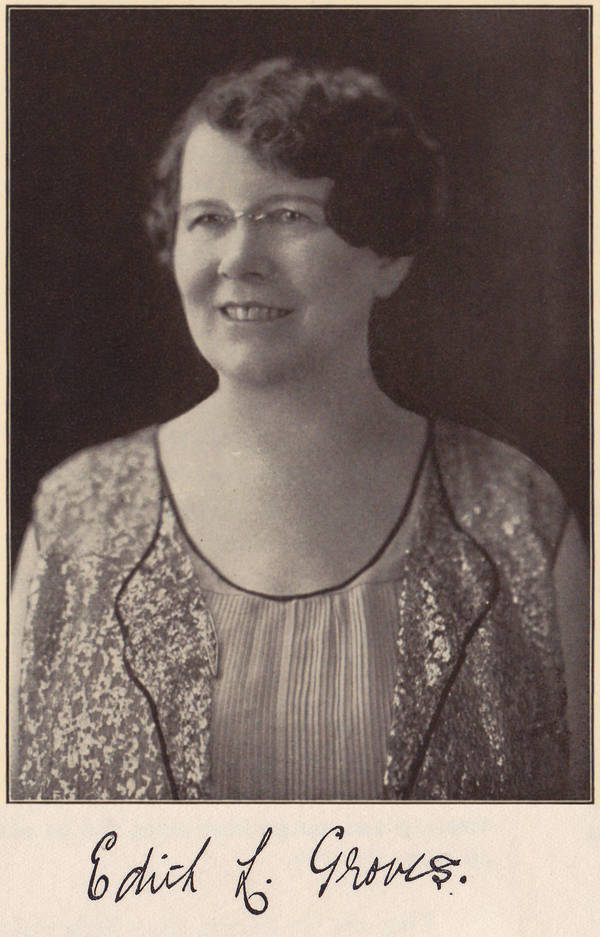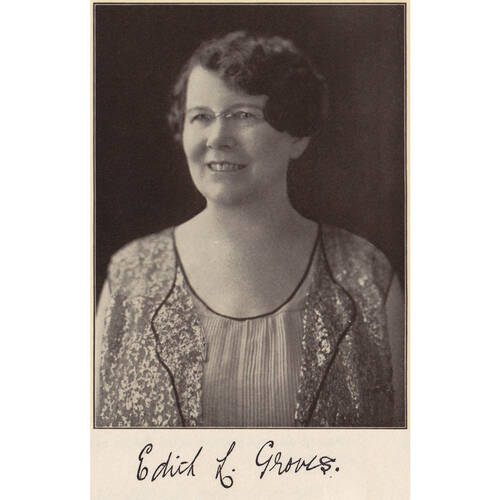
Source: Link
LELEAN, EDITH SARAH (Groves), educator, author, and office holder; b. 22 Jan. 1870 in Cheltenham, England, daughter of Nicholas Lelean and Caroline Jane Clyma; m. 31 July 1907 William Edward Groves (b. c. 1861, d. 25 June 1917), a widower with two sons, in Toronto; d. there 17 Oct. 1931 and was buried in Mount Pleasant Cemetery.
Edith Lelean’s father belonged to a family of French Huguenot stock, many of whose members became shipbuilders and captains of merchantmen in England; her mother’s family was part of the local elite of Truro in Cornwall. In 1882 she emigrated with her parents, a sister, and two brothers to Port Hope, Ont. By 1886 the family had moved to Toronto, where Nicholas opened a crockery and china shop on Queen Street. Edith graduated from Jarvis Street Collegiate Institute and earned her teacher’s certificate at Toronto’s Normal School in 1887 or 1888. At 19 she held her first position with the Toronto Public School Board at Clinton Street School, teaching grade three. The work was not always steady, so in the early years she also gave private lessons in elocution.
Edith’s career between 1895 and 1901 was based largely at Morse Street School, although she taught briefly at Manning Avenue School and also at Ryerson Public School, where she probably met her future husband, William Edward Groves, the principal. From 1902 to 1907 she was at Church Street School, where the recently widowed Groves was then principal, and the two married. Edith went to live with him and his two teenaged sons at 36 Albany Avenue, which remained her home for the rest of her life. As a married woman, Mrs W. E. Groves, as she was now known, was obliged by school-board policy to resign from teaching, but she remained active in education. In time she became vice-president of the Toronto Home and School Council; her other volunteer activities included the vice-presidency of the Toronto Local Council of Women, which she held in the early 1920s, and the presidency of Toronto’s Girl Guides in 1916. In 1915 she was secretary of the Ladies’ Canadian Rifle Club of Toronto, where she was known as a “crack shot.”
Groves was a published author by the turn of the century; her play How the fairies chose their queen was released in Toronto in 1900 – in all, 5,000 copies were printed, a huge number for the time – and was performed in the pavilion of the Horticultural (Allan) Gardens. Later, during World War I, she applied her substantial literary talents to writing works for a patriotic school curriculum. Her fairy stories, marches, and drills celebrate God, king, and country while involving young children in the kinds of song, dance, and play that enlightened educationalists such as Ann Augusta Stowe* advocated. They are also focused on the formation of citizens and nation building; for example, The wooing of Miss Canada (Toronto, 1917) presents an allegory of the country’s new maturity. Between 1914 and 1918 she penned 19 of her 21 plays, an output that made her one of the most prolific woman playwrights of early-20th-century Canada. These plays were staged in school districts throughout the nation.
While it was a time of extraordinary achievement, the Great War was also a time of tremendous loss for Groves: her husband died, one stepson was killed in Belgium, and the other was severely wounded in France. After William’s death, Groves entered educational politics in 1919, contesting a seat on the Toronto Public School Board for Ward 7; from 1920 to 1931 she was re-elected 12 times, 5 times by acclamation. In 1929 she was returned to a one-year term as chair of the board, the first woman to hold the position. During this period Groves also produced a volume of verse, The kingdom of childhood (Toronto, 1925), in which she expresses her deep sympathy with children. Though its pedagogical, moral, and sometimes nonsensical but always musical verses are ostensibly for young readers, they also have a more sophisticated message for adults that cajoles them into thinking from the child’s point of view.
Groves’s years as a teacher with the Toronto Public School Board fell within the 40-year tenure of Inspector James Laughlin Hughes, a great advocate of German educationalist Friedrich Wilhelm August Froebel and his child-centred approach, which dominated reform in the Toronto school system at the turn of the century. Groves embraced this child-first philosophy and the social and pedagogical value it placed on the maternal role of women teachers, as did Hughes and women’s organizations generally, many of which were invited by Groves to make presentations to the board. This outlook also informed the related professional activities in which she was involved, such as the home and school initiative [see Ada Mary Brown*], the kindergarten movement, and the effort to provide schools with free milk, textbooks, and supplies.
Her work on the board began under the stewardship of Inspector Robert Henry Cowley, among whose “greatest concerns was the problem of subnormal children.” Groves shared this preoccupation and made her most substantial and enduring contribution to her profession in the area of special education. Her legacy included the creation of vocational schools and auxiliary classes for what were then known as “crippled” and “mentally defective” children as well as those who were blind and deaf. Groves was responsible for establishing the Bolton Avenue School for Girls, the Jarvis Street Junior Vocational School for Adolescent Boys, and what would later become known, in her honour, as the Edith L. Groves School for Adolescent Girls.
The Toronto school system and its leaders had a progressive reputation, and Groves helped further raise the board’s profile in the area of special education by giving addresses on this and related issues across Canada and the United States and in England and France. She generated interest at home in many of the best practices from abroad and in 1928 was elected president of the International Council for the Education of Exceptional Children. Like her friend and colleague Dr Helen MacMurchy*, Groves participated in the Canadian National Committee for Mental Hygiene’s unsuccessful attempt to establish a farm “colony” for mentally defective children, but the eugenicist views that related defectiveness to biology drove her actions far less than her perception that children’s access to education was being impeded by social factors which could be remedied. She identified the relationship between disability and performance in school and advocated a number of measures, such as a bus to transport handicapped children to the Wellesley Street School, where a division for their instruction had been set up on her recommendation, and proper equipment for students with limited vision in so-called sight-saving classes.
At the end of a much-lauded career, it was said that Groves drew her greatest public support from children, mothers, and teachers, and on her death she was eulogized as sympathetic, progressive, reform-minded, and “the friend of the children.” Her funeral, held at Central Technical School and presided over by Archdeacon Henry John Cody*, was “filled with representatives of the many-sided life of the city,” including “the Mayor, Controllers and Aldermen, the chairman and members of the Board of Education, city officials, principals, teachers and pupils, officers and members of associations, societies and clubs, and a great many personal friends and admirers.… As the funeral cortege left the school and proceeded to Mount Pleasant Cemetery, the streets were lined with school children, and the little ones sat on the curb, awaiting the passing, on her last journey, of their friend, who had made so many journeys for them.”
As well as the works mentioned in the biography, Edith Sarah Lelean Groves is the author of “Special auxiliary classes,” Canadian Journal of Mental Hygiene (Toronto), 1 (April 1919–January 1920): 182–87, and “Report of the fourth annual meeting of the International Council for the Education of Exceptional Children,” in Toronto Board of Education, Minutes of the proc. (Toronto, 1926), 464–70. Her Everyday children: a book of poems (Toronto, 1932) features an essay on Groves (pp. 11–29) by Helen MacMurchy.
The only known portrait of Groves hangs in the Toronto Dist. School Board’s Sesquicentennial Museum and Arch.
Toronto Dist. School Board, Sesquicentennial Museum and Arch., Vert. files, biog., Edith Lelean Groves. “All heads bowed in sorrow at bier of loved trustee,” Toronto Daily Star, 20 Oct. 1931: 3. “Clever authoress writes of children,” Toronto Daily Star, 30 Nov. 1917: 5. “Hope to start colony care for defectives,” Toronto Daily Star, 12 June 1925: 4. Kym Bird, “A bibliography of Canadian drama in English by women, 1880–1920,” in her Redressing the past: the politics of early English-Canadian women’s drama, 1880–1920 (Montreal and Kingston, Ont., 2004), 199–213; “‘I want riches and position and standing among the other nations of the world’: the creation of national subjects in Edith Lelean Groves World War One drama for children, The wooing of Miss Canada,” in Hawaii International Conference on Education, Proc. of the 5th annual conference (Honolulu, 2007), 6943–56. Centennial story: the Board of Education for the city of Toronto, 1850–1950, ed. E. A. Hardy and H. M. Cochrane (Toronto, 1950). Directory, Toronto, 1886–1931. Toronto Board of Education, Minutes of the proc. (1920–31; copies at the Toronto Dist. School Board, Sesquicentennial Museum and Arch.). Toronto Public School Board, Hand book (Toronto, 1892–1907; copies at the Toronto Dist. School Board, Sesquicentennial Museum and Arch.).
Cite This Article
Kym Bird, “LELEAN, EDITH SARAH (Groves),” in Dictionary of Canadian Biography, vol. 16, University of Toronto/Université Laval, 2003–, accessed December 28, 2025, https://www.biographi.ca/en/bio/lelean_edith_sarah_16E.html.
The citation above shows the format for footnotes and endnotes according to the Chicago manual of style (16th edition). Information to be used in other citation formats:
| Permalink: | https://www.biographi.ca/en/bio/lelean_edith_sarah_16E.html |
| Author of Article: | Kym Bird |
| Title of Article: | LELEAN, EDITH SARAH (Groves) |
| Publication Name: | Dictionary of Canadian Biography, vol. 16 |
| Publisher: | University of Toronto/Université Laval |
| Year of publication: | 2017 |
| Year of revision: | 2017 |
| Access Date: | December 28, 2025 |



